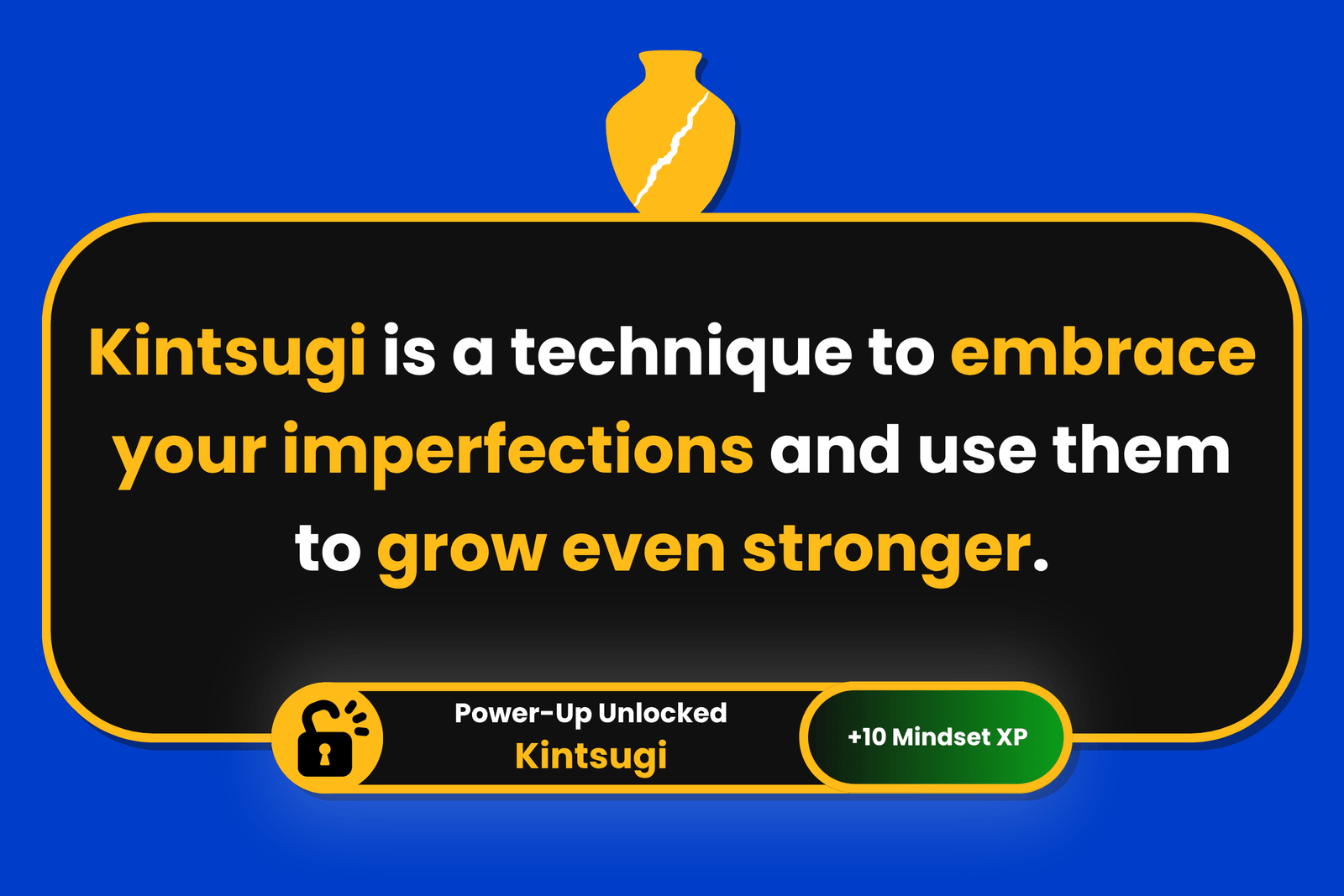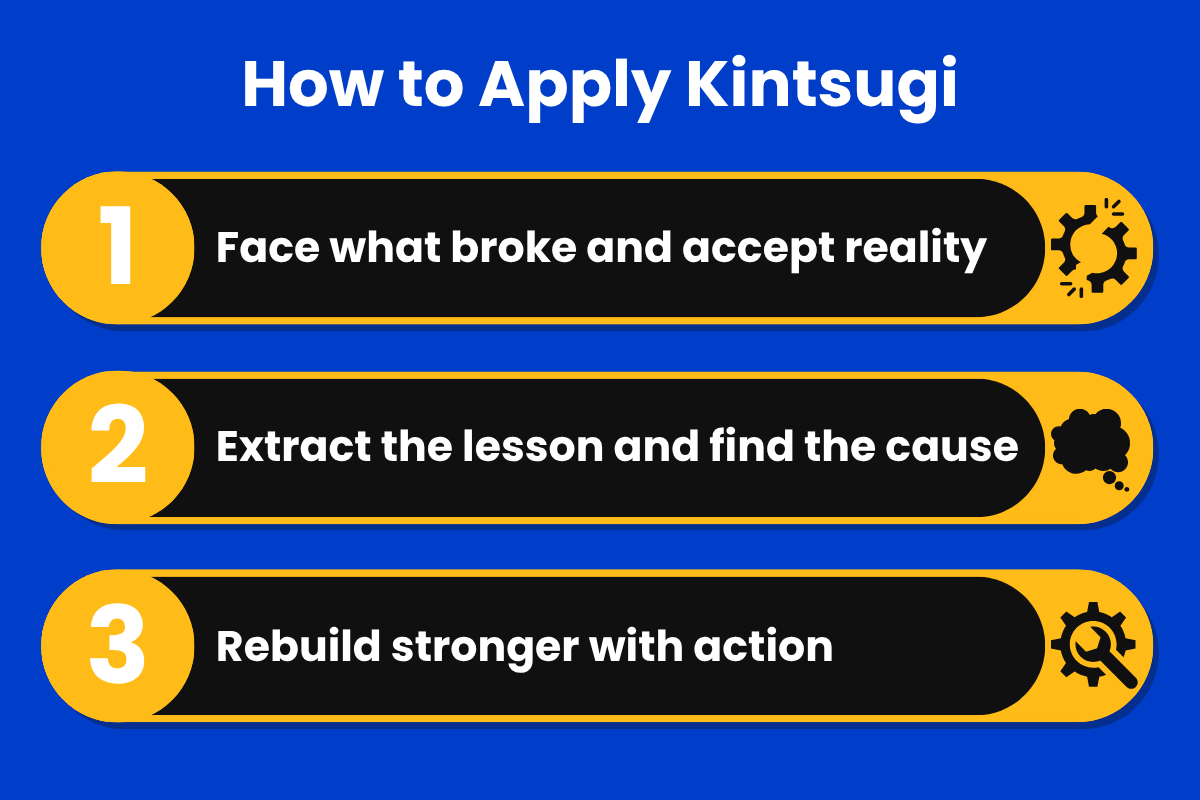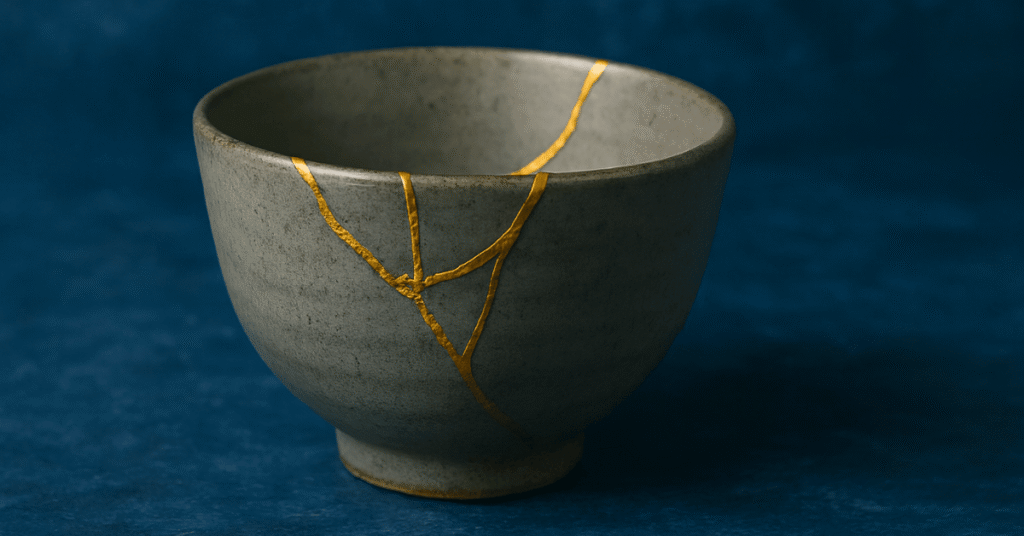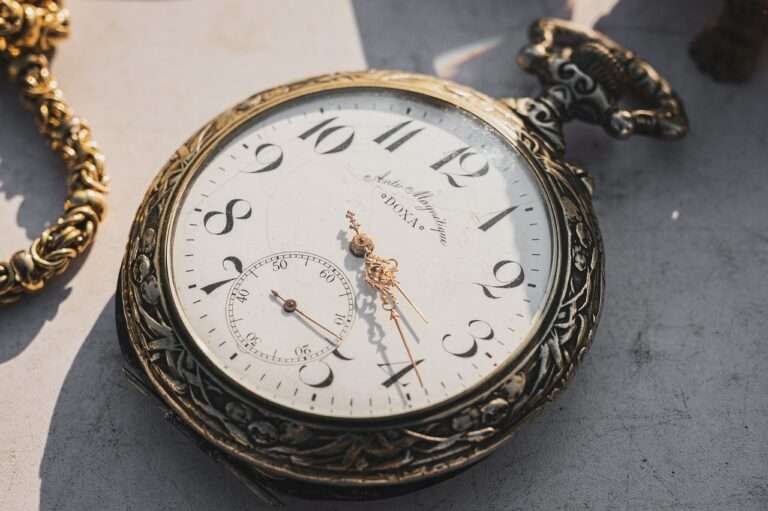Imagine a cracked ceramic bowl being repaired with shimmering gold instead of glue. The result is more beautiful than before it broke. That is kintsugi, the ancient Japanese art of “golden joinery.”
It is more than a craft. It is a philosophy of life. Kintsugi teaches that our scars can become our strengths if we choose to embrace them instead of hiding them.
This guide to the kintsugi mindset will show you how to apply its lessons to your own life, how to rebuild stronger after failure, and how to see beauty in your imperfections.
Contents
What Does Kintsugi Mean?
Kintsugi is the Japanese art of repairing broken pottery with gold, creating something even more beautiful from the cracks. The word kintsugi literally means “to join with gold” (kin = gold, tsugi = join or repair).
The meaning of kintsugi is simple: it transforms damage into beauty instead of hiding it. The repaired object becomes stronger and more valuable than before it broke.
Kintsugi reminds us that our flaws and failures can become our greatest strengths when we embrace them instead of concealing them. This is why people often speak of the meaning of kintsugi in life as well: it represents healing, acceptance, and growth after hardship.
The Origin of Kintsugi
Originally developed in 15th-century Japan, this method used lacquer mixed with powdered gold, silver, or platinum to mend broken ceramics. Over time, it grew beyond craftsmanship into a powerful life philosophy that celebrates imperfection, resilience, and renewal.
How Do You Pronounce Kintsugi?
Kintsugi is pronounced kin-tsoo-gee. The emphasis is gentle and evenly spread, reflecting the calm and deliberate spirit of the art itself.

The Meaning of Kintsugi in Life
When we talk about the meaning of kintsugi in life, we’re really talking about how to face imperfection with strength. Just as cracked pottery is repaired with gold, you can rebuild yourself after hardship and become even more beautiful and stronger for it.
When something breaks, whether it’s a plan, a relationship, or your confidence, it doesn’t mean you’re ruined. It means you have the chance to rebuild with greater strength and purpose.
Living with a kintsugi mindset means shifting from perfection to progress. You stop hiding your scars and start seeing them as symbols of resilience and growth.
In everyday life, that might look like this:
Turning a professional failure into a lesson that improves your next project.
Using a rejection as redirection toward a better opportunity.
Finding pride in the ways you’ve healed, instead of shame in the fact that you were hurt.
So, the true meaning of kintsugi in your life is learning to fill your own cracks with learning, patience, and compassion. You don’t erase your past. Instead, you use it to improve yourself.
▼ Ad
Why We Hide Our Scars, And Why We Shouldn’t
Modern culture often rewards perfection. Social media filters out flaws, success stories skip the struggle, and mistakes are treated like weakness.
Yet the truth is that perfection is lifeless and pretty much impossible to achieve. Real connection and authenticity come from showing what we’ve been through.
The kintsugi philosophy reminds us that trying to hide our cracks only hides our humanity. When you acknowledge pain and still move forward, you gain self-respect and confidence.
Think about how a cracked vase with golden seams captures more attention than a flawless one. It has character. It tells a story. So do you.
How to Apply the Kintsugi Mindset in Your Life
You can practice kintsugi without ever touching a piece of pottery. It begins in how you respond to challenges.
Step 1: Face What Broke and Accept Reality
Pretending you are fine when you are not keeps you stuck. Acknowledge your pain, mistakes, or setbacks. Acceptance is not weakness. No, quite the contrary: it’s the start of growth.
If a relationship ends, accept the loss before rushing to replace it. If a project fails, reflect on what went wrong instead of blaming others. That’s how healing starts.
Step 2: Extract the Lesson and Find the Cause
Once you face the truth, look for lessons. What caused the crack? What did it reveal about your limits or your values?
You can use journaling, meditation, mindfulness, or quiet walks to gain clarity. Reflection turns your pain into wisdom.
Step 3: Rebuild Stronger With Action
Rebuilding is where transformation happens. The “gold” is resilience, compassion, and knowledge gained from experience.
Maybe you lost a job and built a better career because of it. Or failure taught you discipline. Perhaps heartbreak gave you empathy.
When rebuilding your confidence, the words you repeat to yourself matter. Try using positive affirmations to reframe your mindset and reinforce your new habits. That way, each lesson fills the cracks of your past with something valuable.

Real-World Examples of the Kintsugi Mindset
Example 1: J.K. Rowling
Before Harry Potter became a global phenomenon, J.K. Rowling was rejected by twelve publishers and struggling to make ends meet. Instead of giving up, she used each rejection as fuel. Her “cracks” became the foundation of her success. She later said that hitting rock bottom became the solid ground on which she rebuilt her life. That’s kintsugi in action!
Example 2: Michael Jordan
Jordan was cut from his high school basketball team. Most people would’ve quit, but he turned the humiliation into motivation and trained even harder. That failure shaped his mindset and defined his career. His story proves that setbacks can be golden opportunities if you choose to learn from them.
Example 3: You
Think about your own life. Maybe you once failed an exam, lost an opportunity, or made a poor choice that still bothers you (I know I do!). Yet you are reading this now, stronger and wiser. Every healed wound, physical or emotional, has made you who you are. Those are your golden joins.
▼ Ad
Kintsugi Quotes to Inspire You
You can use kintsugi quotes to remind yourself that beauty often comes from imperfection. Here are a few to keep in mind:
“The world breaks everyone, and afterward, some are strong at the broken places.” – Ernest Hemingway
“Scars show us where we have been. They do not dictate where we are going.” – David Rossi
“There is a crack, a crack in everything. That’s how the light gets in.” – Leonard Cohen
Write your favorite one on a note and place it where you see it daily. Let it remind you that it’s okay to fail, and that you can grow stronger as a result.
The Psychology Behind Kintsugi
Growth Mindset and Resilience
The kintsugi mindset perfectly fits with psychologist Carol Dweck’s idea of a growth mindset. People with this mindset see failure as feedback, not as proof they are incapable.
Every crack is a teacher and every setback is a lesson. And when you focus on learning instead of perfection, growth becomes pretty much inevitable.
Self-Compassion and Healing
Research from 2025 shows that self-compassion helps people recover faster from stress and trauma. When you treat yourself with kindness instead of criticism, your brain releases calming chemicals that promote healing. Our positive self-talk exercises can help you with this as well.
Kintsugi teaches that it is not weakness to acknowledge pain. It is courage. The more you practice compassion toward your flaws, the more strength you build for future challenges!
▼ Ad
Common Misunderstandings About Kintsugi
Some people think kintsugi romanticizes pain, but it doesn’t. It does not say that suffering is beautiful; it says that healing is.
This mindset is not about glorifying brokenness but about honoring the process of becoming whole again. It reminds us that repair can create something unique, not ruined.
Another misconception is that kintsugi is only about pottery. In reality, it’s a metaphor for your mindset as well. You do not need lacquer and gold to practice it! You only need awareness and willingness to rebuild.
Final Thoughts: Your Scars Tell Your Story
The philosophy of kintsugi shows that life’s breaks are not the end. They are the beginning of growth.
Every scar is proof that you survived, and every repaired crack makes you even more authentic. When you stop chasing perfection and start embracing progress, you become unshakable.
Your value is not lost when you fall apart. Quite the opposite: it increases once you’ve rebuild yourself with purpose.
If this post inspired you, subscribe to Personal Power-Ups below for more practical mindset upgrades. Keep growing!




